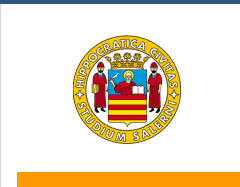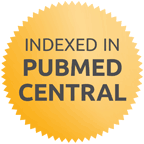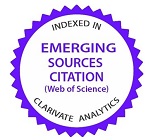For Authors
INTRODUCTION AND GENERAL REQUIREMENTS
Translational Medicine @ UniSa covers all aspects of translational medicine. Manuscripts are accepted for consideration on the condition that they represent original material, have not been published previously, are not being considered for publication elsewhere, and have been approved by each author. Manuscripts that report the results of experimental investigation with human subjects must include informed consent. All manuscript should be accompanied by a Copyright Form signed by all Authors. Submitted article should be accompanied by a cover letter to explain the aim of the study.
TYPES OF ARTICLES
Original Study
Observational and experimental articles are the scientific report of original research. Systematic reviews with meta-analysis are published as original article.
The text (not including abstract, tables, figure legends, and references) must be restricted in length to 3000 words, with no more than a total of 5 tables and/or figures and no more than 50-75 references. A structured abstract (≤ 250 words) is required.
Editorial
Editorials are usually required by the Editor. Editorials provide authoritative scientific and clinical context to articles.
The text (not including tables, figure legends, and references) must be restricted in length to 2000 words, with no more than a total of 2 tables and/or figures and no more than 10 references. This type of manuscript has no abstract.
Review
Review articles will be considered for publication. The subject of a review is the description of the state of art in medicine about a topic relevant in different domains, such as pharmacology and therapy, cellular and molecular mechanism of diseases.
The text (not including abstract, tables, figure legends, and references) must be restricted in length to 3500 words, with no more than a total of 8 tables and/or figures and no more than 100 references. An unstructured abstract (≤ 250 words) is required.
Rapid Communication
The publication of letters to the Editor provide an interesting forum to report short experiences.
The text (not including tables, figure legends, and references) must be restricted in length to 1000 words, with no more than 1 table or figure and no more than 5 references. This type of manuscript has no abstract.
Case Report
This type of article consists in brief report of a clinical case or a small case series reporting the description step by step of a clinical decision making. It must have the evidence of a translational medicine process in its solving. The use of clinical illustrative pictures is strongly recommended.
The text (not including abstract, tables, figure legends, and references) must be restricted in length to 2500 words, with no more than a total of 5 tables and/or figures and no more than 30 references. An unstructured abstract (≤ 100 words) is required.
Letter to the Editor
The publication of letters to the Editor provide an interesting forum to comment about articles recently published.
The text (not including tables, figure legends, and references) must be restricted in length to 1000 words, with no more than 1 table or figure and no more than 5 references. This type of manuscript has no abstract.
Commentary
This manuscript provides an opinion concerning different topics coming from actuality or previous articles.
The text (not including tables, figure legends, and references) must be restricted in length to 2000 words, with no more than 1 table or figure and no more than 10 references. This type of manuscript has no abstract.
MANUSCRIPT PREPARATION
All papers must be submitted electronically using a Word processing package (save in .doc format). Submission of PDF text files is not permitted. Manuscripts should be double-spaced, including text, acknowledgements, references, tables, and figure legends. Each page should be consecutively numbered. Type references in the correct order and style of the journal (see Reference format below). Use Times New Roman for the text font and Symbol for the Greek and special characters. Do not use links to external files.
Check the final copy of your paper carefully before submission.
Authors must divide the text of original articles into the following sections: Title page, Abstract and Keywords, Introduction, Methods, Results, Discussion, Acknowledgements, and References.
Other types of articles (case reports, reviews, editorials, letters) do not require to be divided into these sections. The editors will consider the use of other sections if more suitable for certain manuscripts.
- Title Page
The Title page should report the following information:
Article title. Titles should be concise, but informative. Authors should report all information that will make electronic retrieval of the article both sensitive and specific. Avoid abbreviations where possible.
The full list of authors and for each author a numbered footnote. Clearly indicate the given name(s) and family name(s) of each author and check that all names are accurately spelled.
The footnote should state the author's institutional affiliation.
Corresponding author and contact details (telephone number, fax number, and e-mail address).
A running head (no more than 50 characters long, including spaces).
Declarations of any potential conflicts of interest for each authors.
Word count.
- Abstract
It reflects the content of the article providing the background and the purpose of the study. For original articles, the abstract must be restricted in length to 250 words.
The abstract should be formatted with the following headings: (1) Aims, (2) Methods, (3) Results, and (4) Conclusion.
For Review articles, the abstract must be unstructured and restricted in length to 250 words.
For Case Reports, the abstract must be unstructured and restricted in length to 100 words.
Letter to the Editor, Rapid Communication, Editorial and Commentary articles have no abstract.
- Keywords
To allow retrieval by internet and CD-ROM software, immediately after the abstract, the authors should provide a list of up to 6 keywords separated by commas. These keywords will be used for indexing purposes.
- Text of Article
Article text should be divided as indicated:
Introduction. The introduction provides a context or background and reports the aim of the study or the topics of research. It does not anticipate any results or conclusions of the article.
Methods. In this section, Authors should report any information about the plan of the study: selection and description of the participants, criteria of exclusion/inclusion, technical information about methods, apparatus and procedures, including statistical methods and appropriate indicators of measurement error or uncertainty, description of all drugs and chemicals used, including generic name(s), dose(s), and route(s) of administration.
The application of adequate statistical methods is a prerequisite for publication in TMJ. Authors should define statistical terms, abbreviations, and most symbols, and specify the computer software used.
The authors should state that their study complies with the Declaration of Helsinki, that the locally appointed ethics committee has approved the research protocol and that informed consent has been obtained from the subjects (or their legally authorized representative).
Results. Results should be presented in logical sequence in the text, tables, and illustrations, giving the main or most important findings first. Numeric results should be given not only as derivatives but also as the absolute numbers. Graphs and tables should be used to summarize data avoiding to duplicate information. Graphics should be in TIF, JPEG or GIF.
Tables and figures should be supported by a title and captions for each.
Discussion. In this section Authors should emphasize the new and important aspects and the results of the study. It is necessary to avoid the repetition of data and information given in methods or results. For original articles, it is useful summarizing the main findings, exploring mechanisms or explanations, comparing the results with other studies, reporting the limitations of the study and the future implication of the results.
- Acknowledgement
All persons named in the Acknowledgments section have provided the corresponding author with written permission to be named in the manuscript.
Use the singular heading even if you have many acknowledgments. Avoid expressions such as “One of us (J.Q.A.) would like to thank ... .” Instead, write “J. Q. Author thanks ... .”
Sponsor and financial support acknowledgments are placed in the on the first page.
- References
References should be identified in the text by Arabic numerals and numbered as they appear in the text in squared brackets. All references should be compiled at the end of the article in the Vancouver style (i.e. author-number system).
Complete information should be given for each reference, including the title of the article, abbreviated journal title, and page numbers. Avoid using abstracts as references. References to papers accepted but not yet published should be designated as “in press”. References from internet should be followed by the URL.
The general format for a reference to a journal article is:
Authors’ name; article title; Journal title; date of publication; volume (issue): pages. Names should be written as they appeared in the text to avoid mistakes. For each Authors surname should be written first, then first and middle name as initials should be signed for a maximum of two initials for each Author. All the authors should be listed (avoid “et al.”).
Title should be reported as it appears in the publication, capitalizing only the first word of a title, proper nouns, proper adjectives, and acronyms. If a title contains a Greek letter or some other symbol that cannot be reproduced with the type fonts available, the symbol should be substitute by the name, for example write gamma or alpha. Non-English titles should be translated into English and the translation should be reported in brackets.
The Journal Title should be abbreviated according to the style used in the list of Journals Indexed for Medline. If a journal is not listed in Medline, its name should be written out in full.
The Date of Publication include the year of publication. Roman numerals should be converted to Arabic numbers. The date should be followed by the Arabic number of the volume. The words “volume” or “vol” should be omitted, multiple volumes should be separate by a hyphen, such as 5-6 or 42-43. In brackets it is reported the number of the issue in Arabic number without “number” or “no” and separating multiple issue by a hyphen. After volume and issue if it is necessary it should be reported the supplement. A colon should separate volume or issue from pagination. Page numbers should be reported as they appear in the article in PDF. Pagination information ends with a period.
Language should be reported if not English in brackets.
Article citation examples:
[1] Sorriento D, Santulli G, Fusco A, Anastasio A, Trimarco B, Iaccarino G. Intracardiac Injection of AdGRK5-NT Reduces left Ventricular Hypertrophy by Inhibiting NF-kappaB-Dependent Hypertrophic Gene Expression. Hypertension 2010;56(4):696-704.
Book citation example:
[1] Jenkins PF. Making Sense of the Chest x-ray: a Hands-on guide. New York: Oxford University Pree; 2005. 194 p.
Webpage citation example:
[1] National committee of Bioethics. I Criteri di Accertamento della Morte. (Criteria for the Declaration of Death) [Internet] 2010 [cited 2012 Jul 18]. Available from: http://www.governo.it/bioetica/pareri_abstract/criteri_accertamento_morte24062010.pdf (Italian)
- Tables
Tables should be typed with double spacing, but minimizing redundant space, and each table should be reported on a separate sheet. Each table should be numbered in sequence using Arabic numerals. Tables should also have a short descriptive heading above with footnotes and/or explanations underneath.
- Figure Legends
Ensure that each figure has a caption. Supply figure legends separately, not attached to the figure. Figure legend should comprise a brief title (not on the figure itself) and a description of the illustration.
Figure legends should be on a separate sheet of the manuscript. Define all symbols and abbreviations used in the figure.
FIGURES
Figures should be saved in TIFF, JPEG or GIF format at a resolution of at least 300 dpi at the final printed size for color figures and photographs, and 1200 dpi for black and white line drawings, and uploaded as separate files. Please use the drawing tools in Word or Visio to finish your figures and tables.
Figure axis labels are often a source of confusion. Try to use words rather than symbols. As an example, write the quantity “Magnetization,” or “Magnetization M,” not just “M.” Put units in parentheses. Do not label axes only with units. As in Fig. 1, for example, write “Magnetization (A/m)” or “Magnetization (A m-1),” not just “A/m.” Do not label axes with a ratio of quantities and units. For example, write “Temperature (K),” not “Temperature/K.”
Multipliers can be especially confusing. Write “Magnetization (kA/m)” or “Magnetization (103 A/m).” Do not write “Magnetization (A/m) x 1000” because the reader would not know whether the top axis label in Fig. 1 meant 16000 A/m or 0.016 A/m. Figure labels should be legible, approximately 10-point type.
SUPPLEMENTARY MATERIAL
Authors may submit supplementary material to accompany their article for online-only publication when there is insufficient space in the print article. Supplementary material may include images, videos, supplementary methods/results, tables, and figures. For each file, please supply a concise, descriptive caption.
Supplementary text and tables should be submitted in a single Word document with pages numbered consecutively. The first page of the document should list the number and title of each item included in the document.
Supplementary files are published exactly as they are received.
ABBREVIATIONS AND ACRONYMS
Do not introduce an acronym unless you will use it a minimum of three or four times. Define abbreviations and acronyms the first time they are used in the text, even after they have already been defined in the abstract. Abbreviations such as TM, SI, MKS, CGS, ac, dc, and rms do not have to be defined. Abbreviations that incorporate periods should not have spaces: write “C.N.R.S.,” not “C. N. R. S.” Do not use abbreviations in the title unless they are unavoidable.
EQUATIONS
Number equations consecutively with equation numbers in parentheses flush with the right margin, as in (1). To make your equations more compact, you may use the solidus ( / ), the exp function, or appropriate exponents. Use a long dash rather than a hyphen for a minus sign. Use parentheses to avoid ambiguities in denominators. Punctuate equations with commas or periods when they are part of a sentence, as follows:
A + B = C. (1)
Be sure that the symbols in your equation have been defined before the equation appears or immediately following. Italicize variables (T might refer to temperature, but T is the unit tesla). Refer to “(1),” not “Eq. (1)” or “equation (1),” except at the beginning of a sentence: “Equation (1) is ... .”
OTHER RECOMMENDATIONS
Avoid dangling participles, such as, “Using (1), the potential was calculated.” Write instead, “The potential was calculated using (1),” or “Using (1), we calculated the potential.”
Use a zero before decimal points: “0.25,” not “.25.” Use “cm3,” not “cc.” Indicate sample dimensions as “0.1 cm x 0.2 cm,” not “0.1 x 0.2 cm2.”
Finally, you are responsible for language as editors will not check it. Do a spell and grammar check. This is available in Word. If English is not your native language, get a professional proof-reader to help if possible.
COPYRIGHT
It is a condition of publication that manuscripts submitted to this journal have not been published and will not be simultaneously submitted or published elsewhere. Plagiarism is strictly forbidden, and by submitting the article for publication the authors agree that the publishers have the legal right to take appropriate action against the authors, if plagiarism or fabricated information is discovered.
During submission process authors have to declare their legal right.
By submitting a manuscript the authors agree that the copyright of their article is transferred to the publishers if and when the article is accepted for publication.
Once submitted to the journal, the author will not withdraw their manuscript at any stage prior to publication.




